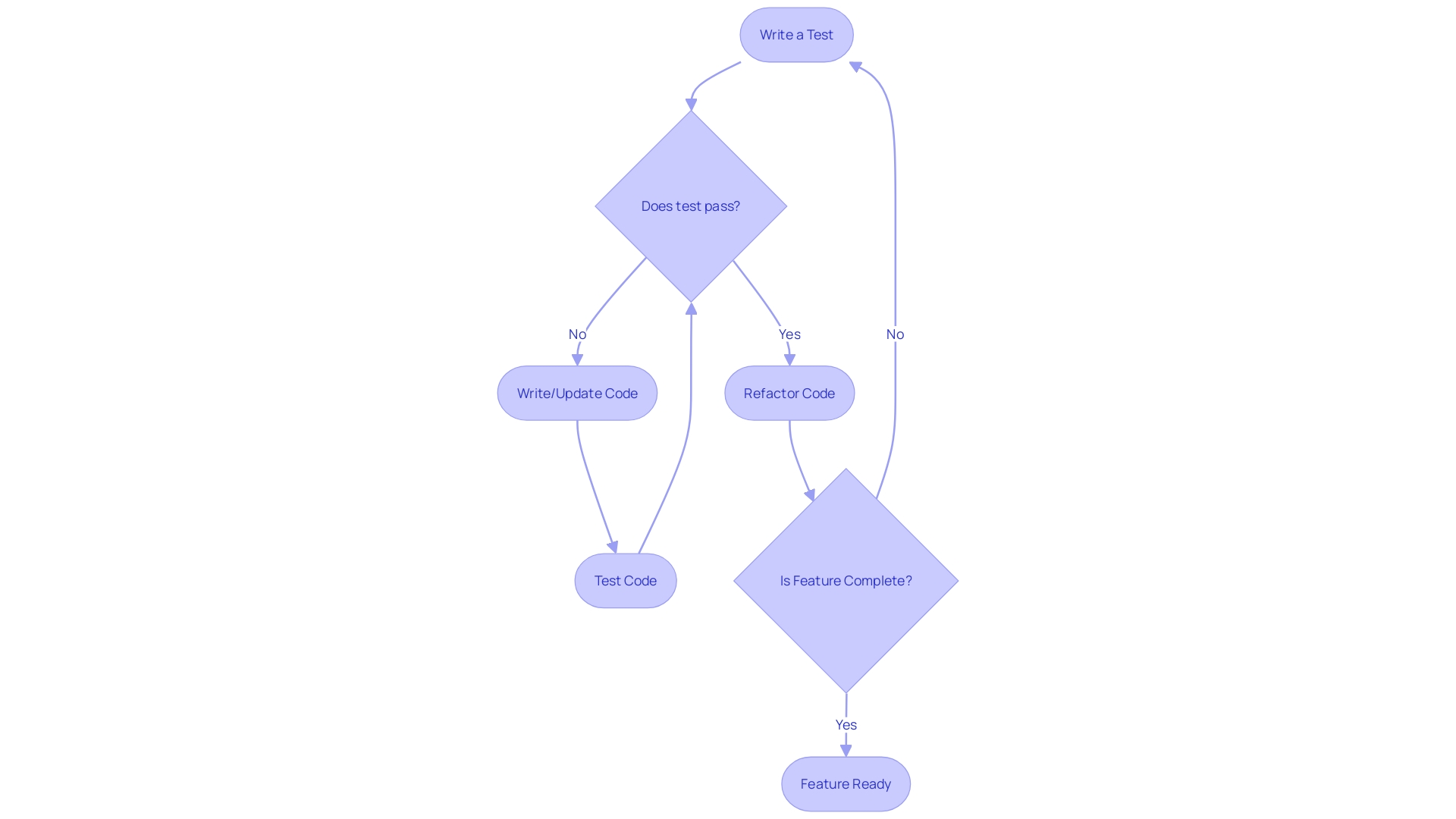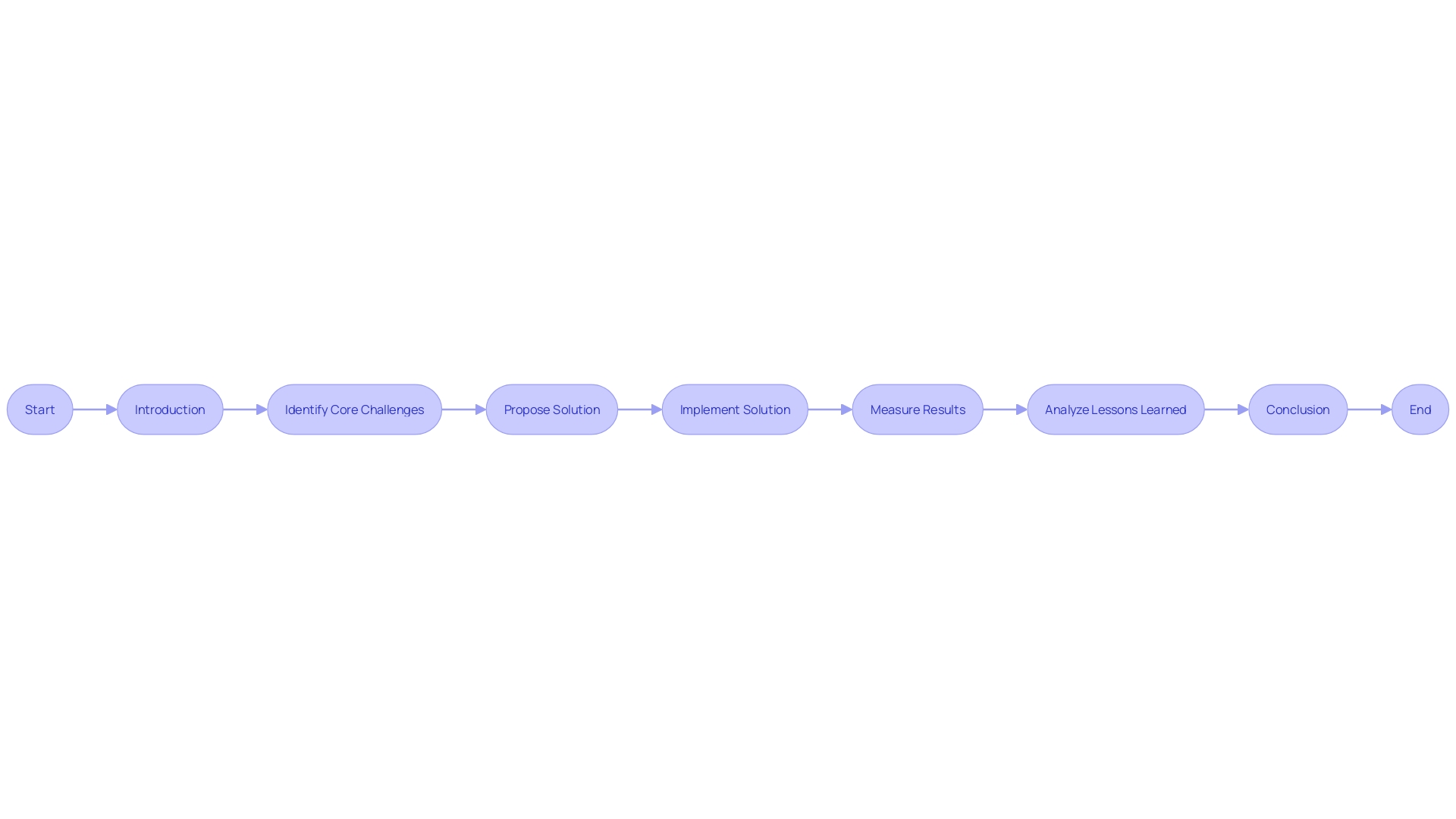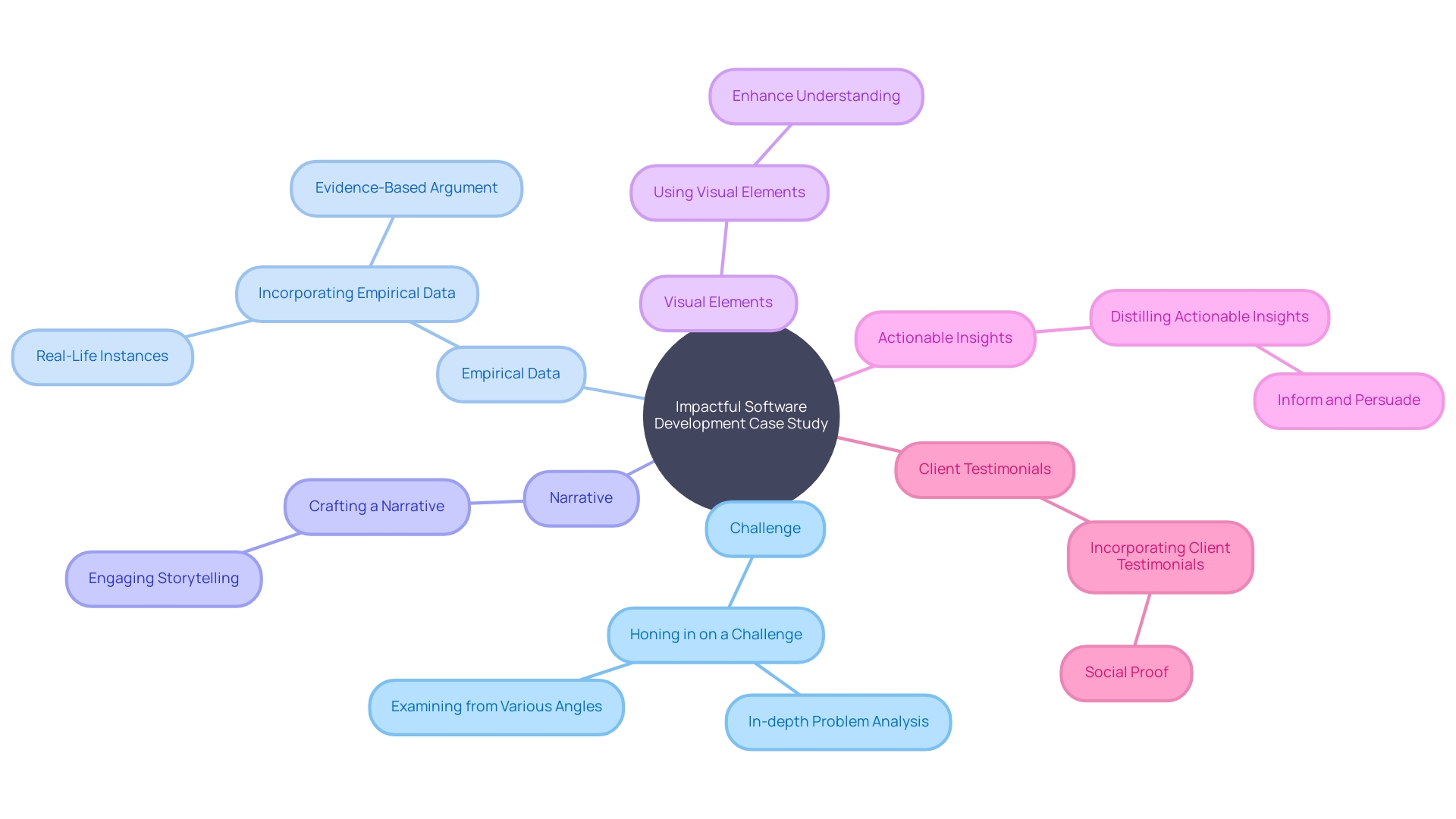Introduction
Delving into case studies offers a multifaceted view of software development, shedding light on the intricate dance between technology and human expertise. Each case study is a treasure trove of knowledge, charting the journey from initial concept to final product, and providing a roadmap for overcoming obstacles along the way.
In this article, we will explore the benefits of case studies in software development and how they can enhance the development process. We will also delve into real-life examples of software development case studies, showcasing the practical challenges and triumphs of deploying technology in various industries.
Additionally, we will examine the impact of Test-Driven Development (TDD) on software quality and speed, with real-life examples illustrating its efficacy. Furthermore, we will discuss a case study template for software development, outlining a structured approach to creating compelling case studies. We will highlight best practices for writing a case study that resonates with the intricacies of the field, incorporating empirical data, storytelling, visual elements, and testimonials to create an impactful narrative. Join us as we delve into the world of software development case studies, uncovering valuable insights and wisdom for developers seeking to enhance their craft and deliver impactful solutions.
Benefits of Case Studies in Software Development
Delving into case studies offers a multifaceted view of software development, shedding light on the intricate dance between technology and human expertise. Each case study is a treasure trove of knowledge, charting the journey from initial concept to final product, and providing a roadmap for overcoming obstacles along the way.
Take the example of Dectar, a cybersecurity firm managing documentation in multiple languages. Initially, their support team was overburdened, often working overtime to produce release notes in sync with software releases.
By appointing a dedicated owner for documentation, Dectar streamlined this process, enhancing efficiency and reducing the workload on their support team. Furthermore, the use of use cases, as expounded by Alistair Cockburn, offers a potent tool in bridging the gap between business and engineering.
By capturing user requirements in use cases, developers gain a clear guide for crafting solutions that resonate with user needs, even enabling technically adept users to contribute to software creation. Incorporating strategic tech debt, as suggested in the research-to-product lifecycle, can accelerate the exploration phase, allowing for a swift assessment of diverse solutions.
This is crucial in a research-oriented environment where the goal is to innovate rapidly. A comprehensive understanding of software development methodologies is pivotal.
They provide a scaffold for the development journey, outlining roles, responsibilities, and processes. This framework is integral to moving from concept to completion with clarity and purpose. Lastly, viewing documentation from the reader's perspective is essential. Whether it's a user manual or developer guidelines, the language and focus must align with the technical acumen of the audience to ensure comprehension and utility. In sum, case studies not only chronicle the triumphs and trials of software development but also impart wisdom for future projects. They are an indispensable resource for developers seeking to enhance their craft and deliver solutions that truly make an impact.
Software Development Case Study Examples
Case studies in software development offer invaluable insights into the practical challenges and triumphs of deploying technology in real-world scenarios. For instance, consider the transformation of XYZ Company as they adopted Agile methodologies.
They encountered several hurdles, such as resistance to change and adapting to new workflows. However, by embracing strategic technical debt during the exploration phase and focusing on robust solutions in the exploitation phase, they streamlined their development process.
The outcome was a more responsive and efficient software delivery that positively impacted their business operations. Another compelling example is ABC Healthcare's journey to create an electronic medical records system.
This case study delves into the complex requirements of healthcare technology, such as compliance with regulations and the need for high data accuracy and security. The development team's commitment to thorough code reviews and quality assurance ensured that the final product not only enhanced patient care but also improved the organization's operational efficiency. Lastly, DEF E-commerce Platform's scalability issue is a common challenge for fast-growing businesses. Through the implementation of a scalable architecture and optimization of their software infrastructure, DEF successfully managed their growth without compromising on performance. This case study demonstrates that with meticulous planning and execution, scalability obstacles can be transformed into opportunities for business expansion and improved customer satisfaction.
Real-Life Examples of TDD Improving Quality and Speed
Embracing Test-Driven Development (TDD) has proven to be a game-changer in the realm of software development, particularly when it comes to maintaining the delicate balance between rapid innovation and the steadfast assurance of quality. In the fast-paced technological landscape, TDD serves as a beacon, guiding developers through the complexities of creating robust, dependable software with the added benefit of significant cost savings and ROI.
Taking a closer look at real-world applications of TDD, we see PQR Company's mobile app development journey. With TDD, the team was able to preemptively tackle bugs, paving the way for an app that was not only of superior quality but also boasted a significant reduction in post-launch issues.
This preemptive quality control is a testament to the power of TDD in enhancing the reliability of digital products. MNO Software's experience with TDD during their web application upgrade further illustrates the methodology's efficacy.
By rigorously testing each new feature and meticulously refactoring the existing code, MNO Software fortified the application's stability and trimmed down the time devoted to debugging, showcasing TDD as a catalyst for efficiency. Lastly, GHI Tech's API development project highlights TDD's versatility.
The team crafted tests encompassing a variety of use cases, which enabled swift identification and rectification of issues. This led to the creation of a robust API that not only met but exceeded performance expectations.
These case studies underscore the transformative impact of TDD on the software development process. As echoed by industry leaders and the evolution from the Fordism era, the necessity for thorough testing prior to release cannot be overstated. It is a strategic move that not only preserves but also amplifies the value delivered to users. Moreover, as noted by Markos Fragkakis of Workable, the separation of concerns principle, integral to TDD, simplifies complexity and elevates code quality. This principle, along with modularity, clarity, and independence, forms the cornerstone of testable code, ensuring that each function can stand alone, free from the intricate web of dependencies. In the world of continuous integration and delivery, where the pace of development is relentless, TDD emerges as an indispensable ally, equipping QA teams with the tools to ensure that the march towards innovation does not come at the cost of quality or user satisfaction.

Case Study Template for Software Development
Creating a compelling case study in software development requires a structured approach, capturing the journey from initial challenges to successful outcomes. Begin with an introduction that sets the stage, describing the project and its goals succinctly.
Next, articulate the core challenges that necessitated a new solution, framing the problem statement with precision. The solution section should narrate the strategic approach, highlighting the use of use cases—a technique championed by Alistair Cockburn—as a foundation for capturing user requirements.
This establishes a clear guide for development, ensuring that the end product aligns with user needs. Elaborate on the implementation phase by detailing the steps undertaken, the technologies and methodologies selected, and how any roadblocks were surmounted, perhaps drawing on Doctor's experience in streamlining their documentation process to reduce the Support Team's workload.
Results should be quantified to demonstrate tangible benefits, which might include efficiency gains or cost savings, akin to how Dectar achieved documentation fluency across multiple languages. A reflective section on lessons learned offers valuable insights for future projects, fostering a culture of continuous improvement. Conclude the case study by reinforcing its significance to the broader software development landscape, reflecting on the adaptability of the waterfall model, as detailed by Bassil, and its structured design, which Dennis et al. note replaced more ad hoc methods. The case study should serve as a microcosm of the industry's evolution toward more systematic and user-centric development processes.

Best Practices for Writing a Case Study
Creating an impactful software development case study hinges on certain best practices that resonate with the intricacies of the field. Begin by honing in on a particular challenge and its resolution.
This specificity is the bedrock of understanding the problem domain, which is crucial in navigating the complexities of software development. To scaffold your narrative with credibility, integrate empirical data and metrics, illuminating the tangible benefits of the solution.
A compelling case study is also a tapestry of storytelling—craft a narrative that traverses the hurdles and triumphs encountered during the project's lifecycle. Visual elements are not mere embellishments but essential tools that crystallize concepts and processes.
Diagrams, screenshots, and infographics serve as visual anchors for your audience, simplifying complex ideas. It's also paramount to encapsulate the essence of your case study in clear takeaways, distilling actionable insights that peers can readily apply.
Moreover, the authenticity of a case study is amplified by the voices of those it impacts. Garner testimonials from clients or users who have reaped the solution's rewards; their firsthand accounts serve as potent social proof. According to research, the maintenance phase of software lifecycle management consumes a significant portion of resources, underscoring the importance of effective solutions that are well-documented in case studies. As you embark on crafting your case study, remember the words of an industry observer: 'An unclear problem domain is akin to navigating without a compass.' This wisdom echoes the necessity of a focused approach in software development projects. By adhering to these best practices, your case study will not only inform but also inspire, guiding your audience through a journey of discovery and learning.

Conclusion
In conclusion, software development case studies provide valuable insights into the intricate relationship between technology and human expertise. They offer a roadmap for overcoming challenges, enhancing efficiency, and driving business growth.
Real-life examples from companies like Dectar, XYZ Company, ABC Healthcare, and DEF E-commerce Platform demonstrate how strategic approaches can streamline processes and improve customer satisfaction. These examples showcase the practical challenges faced in different industries and the successful outcomes achieved through innovative solutions.
Test-Driven Development (TDD) emerges as a game-changer in maintaining the delicate balance between rapid innovation and quality assurance. PQR Company, MNO Software, and GHI Tech exemplify how TDD enhances software quality, reduces post-launch issues, improves stability, and boosts user satisfaction.
Creating impactful case studies requires a structured approach. Incorporating use cases, quantifying results, reflecting on lessons learned, and emphasizing the significance of the study are key elements. Best practices include focusing on specific challenges, integrating empirical data and storytelling techniques, utilizing visual elements, encapsulating clear takeaways, and including testimonials for social proof. In summary, software development case studies offer valuable wisdom for developers seeking to enhance their craft. By studying these cases and following best practices for writing them, developers can navigate complexities effectively and deliver solutions that have a lasting impact on businesses and users alike.





